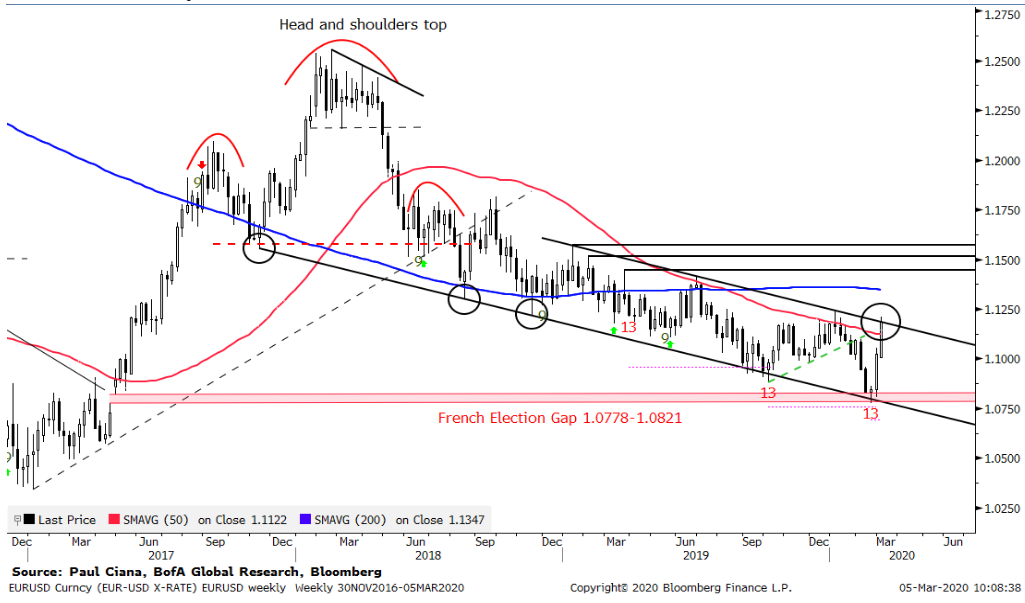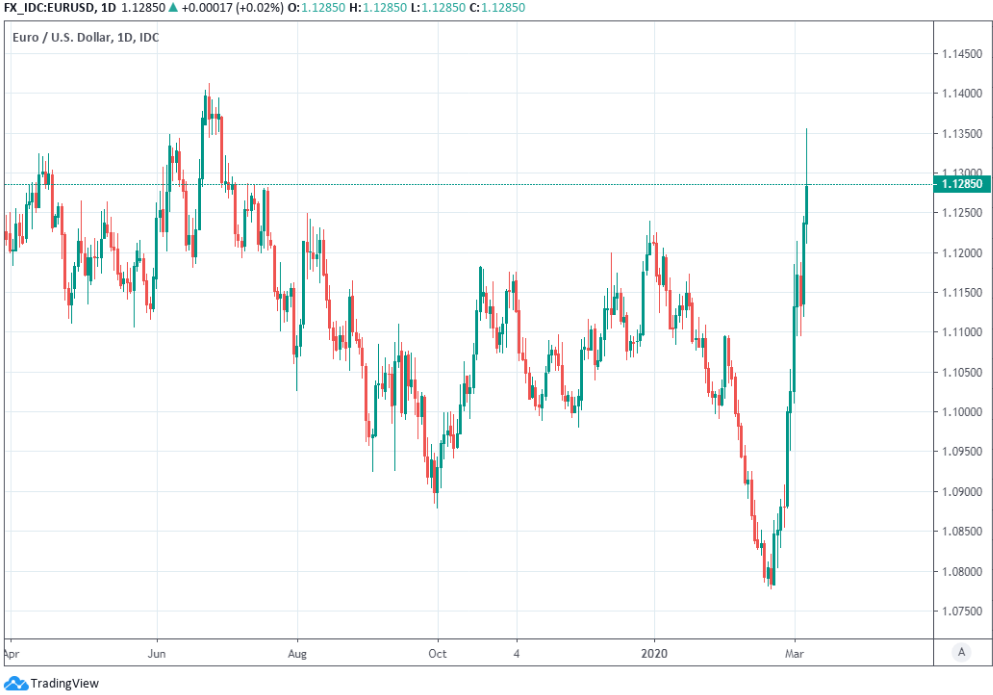The Euro-to-Dollar Week Ahead: Charts Tip More Gains as Market Digests Italian Quarantine
- Written by: James Skinner
- EUR breaking higher on charts after overcoming resistance.
- Technical analysts tip more gains ahead, eyeing 1.14 & 1.15.
- But EUR faces market response to Italy quarantine Monday.
- Quarantine threatens IT economy, incites further risk sell-off.
- Ahead of Thursday's ECB decision, analysts call for rate cut.
- EUR to keep benefiting from EM, equity position liquidations.

© Adobe Stock
- EUR/USD Spot rate: 1.1279 up +2.35% last week
- Indicative bank rates for transfers: 1.0892-1.0971
- Transfer specialist indicative rates: 1.1118-1.1185 >> Find Out More About This Rate
The Euro-to-Dollar rate rose more than two percent last week and overcame two key technical obstacles in the process, leaving it with a clear path toward year-long highs although it's not yet clear what impact the Italian government's quarantine of millions of its citizens will have on the exchange rate.
Europe's single currency has reached a nine-month high on Friday and after overcoming the 1.12 and 1.1239 levels it now has the 1.14 threshold and above in its sights, although the Euro will be preoccupied early in the new week with the market's to the Italian government's Sunday decision to expand a quarantine in the Lombardy region to include what is estimated to be around a quarter of the country's population.
Citizens may no longer enter or leave 14 affected areas and nor can they move around freely inside of them until at least April 03, according to decree signed by the government as it seeks to contain a growing coronavirus epidemic. The decision is another blow to the European and global growth outlooks, and could easily incite a fresh sell-off in risk assets on Monday although the likely response of the Euro-to-Dollar rate is difficult to gauge given its recent tendency to rise when global markets fall apart.
"Within a short span of two weeks EUR/USD went from filling the French election gap and reaching our year ahead technical target to the top of the downward sloping channel that began in the 2H18. This channel has been tested before but euro failed a technical litmus test in January with no weekly close above 1.12 and then declined to fill the gap. This week/month, euro is testing the top of this channel again," says Paul Ciana, chief technical strategist at BofA Global Research. "A weekly close above the YTD high of 1.1239 should support a move higher in 1H20 such as the 200wk SMA at 1.1347, pivot highs of 1.1448, 1.1514 and 1.1570."
Above: Euro-to-Dollar rate shown at weekly intervals, testing trendline resistance. Source: Euro-to-Dollar rate.
The Euro closed last week at 1.1285, well above the 1.1185, 1.12 and 1.1239 resistance levels that barred its path higher in January, and BofA's Ciana says the 1.1347 and 1.1448 thresholds are now viable targets for the single currency. The 1.1185 level marked the top of a downward sloping trend channel comprised of a series of lower-lows and lower-highs that's been carved out by the downtrending Euro ever since the beginning of the second quarter 2018.
"A touch of the 1.13 level looked unimaginable just two weeks ago when the EUR reached a near three-year low and settled into its longest oversold period since mid-2018; it is now overbought. Support is 1.1212 followed by 1.1200 while the 1.1350 mark may act as a soft psychological resistance marker on the way to 1.1400," says Juan Manuel Herrera, a strategist at Scotiabank.
The Euro had traded at two-year lows as recently as the middle of February after the Eurozone's chronic economic underperformance was seen making it likely that the European Central Bank (ECB) would leave its interest rate at zero and its deposit rate below zero for years to come. That incentivised investors to borrow cheap Euros and then sell them in exchange for investments in more lucrative, higher-yielding assets like the Dollar and emerging market currencies.
But the coronavirus-induced collapse of stock and commodity markets has stoked exchange rate volatility and led investors to exit 'carry trades,' which requires them to buy back the Euro. And it's that trend that explains why the Euro might actually rise on Monday if the investor response to Italy's emergency decree sees risk assets coming under renewed pressures, even though the quarantine of millions of Italians will hurt the European economy before any other.
"Above lies the 1.1300 55 month moving-average and the 200 week ma at 1.1346. This is critical from a longer term perspective, a weekly close above here would target the 12 year downtrend at 1.1950," says Karen Jones, head of technical analysis for currencies, commodities and bonds at Commerzbank.
Above: Euro-to-Dollar rate shown at daily intervals.
AA
The Euro: What to Watch
The Euro outperformed all major rivals other than the safe-havens again last week as investors continued to liquidate earlier Euro-funded bets on higher risk assets, a trend that could continue over the coming weeks no matter what the European Central Bank (ECB) says or does on Thursday.
Europe’s single currency will be preoccupied early in the new week by the market response to a significant expansion of the Italian government’s coronavirus containment measures, which saw an estimated 17 million people placed under ‘lockdown’ at the weekend, up from just 50,000 previously.
The Italian government ordered in the early hours of Sunday that 14 provinces, which are home to around a quarter of Italy’s population, be placed under lockdown with nobody able to enter or leave the affected areas nor move around freely inside them.
Sunday’s emergency decree will bring significant disruption to Europe’s most fragile major economy and may prompt questions about whether such measures will eventually be seen in other major economies like the U.S., UK, France and Germany, which are also grappling with building outbreaks. The decree followed a decision from last Thursday to close all of Italy’s schools and universities until after March 15.
And it should really be bad news for the Euro given the bloc’s already fragile economy. However, it's not clear how the exchange rate will respond to it given that it was again lifted last week by the liquidation of earlier bets on higher risk assets further afield.
Those bets were funded using Euros that were super cheap to borrow due to the European Central Bank’s negative interest rate. That position liquidation has lifted the EUR/USD rate more than 3% in the last month as stock markets fell apart the world over and emerging market currencies tanked.
“It looks like the ECB didn’t want to play ball with a co-ordinated rate cut – genuinely believing lower rates would do more harm than good. This puts it in a tricky spot for next week’s ECB meeting. We think it wants to avoid a rate cut and instead will be looking at targeted measures to support corporate and SME lending, e.g. a TLTRO targeting the corporate sector. The lack of a ‘bazooka’ from the ECB may add to pessimism in risk assets (and pressure on the Fed to do the heavy-lifting with easing) and keep EUR/USD bid,” says Chris Turner, head of FX strategy at ING.
Coronavirus has spread to more than 90 countries, infecting more than 100,000 people and claiming more than 3,400 lives, and the disease has spread this last week with increasing momentum in Europe. It’s also spreading rapidly in the U.S. by many accounts, although the full extent of the problem is not known due to a lack of testing equipment at the state level. And as the problem grows larger investors could continue to mark down the global growth outlook, sell risk assets and bid for safe-havens.
The rising Euro is another headache for the ECB, which announces its latest interest rate decision at 12:45 Thursday, given that it risks exacerbating the chronic disinflationary condition of the Eurozone economy. A higher exchange rate can reduce import costs as well as consumer prices, which won't be at all welcome at an ECB that's already cut its deposit rate far below zero in the hope of stoking the faster growth necessary for it to sustainably deliver its target to ensure inflation of "close to, but below 2% over the medium term".
“To be clear, rate cuts and QE will not do much to help SMEs at this juncture but would likely increase the odds that we would see a stronger recovery once we are through the peak of the Coronavirus,” says Marchel Alexandrovich, an economist at Jefferies International. ”A package of measures focused on liquidity, interest rates and asset purchases, seems likely. What precise combination the ECB will choose will depend on how events unfold over the coming week (particularly the extent of the spread of the infection in the US) and whether what is currently taking place in Italy (in terms of school closures) is replicated in other parts of Europe.”
Consensus is looking for the ECB to leave all of its interest rates unchanged at 12:45 Thursday although the risk is the bank decides to cut the deposit rate and announce other measures that might include tweaks to its quantitative easing program or another round of cheap loans for banks to support Europe’s economy and lean against the rising Euro. But it’s far from clear that this will be enough to stop the Euro’s advance, which is being driven by investors exiting wagers on higher risk assets in a process that could continue for a while yet.
The ECB is highlight of economic calendar for the week ahead although there is also a range of other figures set to be released over the coming days including industrial production numbers for January and the second estimate of final quarter GDP, which economists see being revised up from 0.1% to 0.2% at 10:00 on Tuesday.
“Again we doubt that data will have much bearing at all on the FX markets. Instead investors will now also be focusing on the politicians. Do they passively allow fiscal stimulus by suspending budget rules in a slowdown or actively pursue spending to fill a hole in domestic demand? We expect 1.12 to prove good EUR/$ support now,” says ING’s Turner.
AA
The Dollar: What to Watch
The Dollar was a laggard among major currencies last week after the Federal Reserve took an axe to the Fed Funds rate and many expect it to remain an underperformer now that its interest rate advantage over other currencies has been weakened and the coronavirus is spreading in the U.S.
There is no major economic data due from the U.S. this week so Dollar exchange rates will take cues from the movements of other currencies, changes in risk appetite and developments around the spread of coronavirus in the U.S. This is after the Fed cut its interest rate by 50 basis points to between 1% and 1.25% in an unscheduled decision, significantly reducing the greenback’s yield advantage over other major rivals, which is now weighing on the Dollar.
“The Fed signalled clearly that the door remains open for more easing in the coming months. It has contributed to the sharp fall in US yields to record lows with the 10- year US Treasury bond yield falling to 0.66%,” says Lee Hardman, a currency analyst at MUFG. “With US yields falling faster than overseas, the yield pick-up in holding USD’s is fast diminishing. It makes it harder to justify the USD remaining at such overvalued levels.”
The Dollar could start the week on the back foot against safe-havens like the Japanese Yen, Swiss Franc and possibly even the Euro as investors respond to the Italian government’s emergency decree placing an estimated 17 million people under ‘lockdown’ in the Lombardy regions as it seeks to slow the spread of coronavirus across the country. It instructed at the weekend that nobody be able to enter or leave, or move freely within 14 provinces in Lombardy until at least April 03.
Italy’s government is effectively taking a quarter of its economy offline in an effort to fight the virus, although the danger for the Dollar, Pound and other currencies is that investors soon begin to ask how long it will be before such measures are contemplated in the U.S., UK and other countries where there are signs of an outbreak. Such questions would likely be unhelpful to both currencies, especially in relation to the Yen, Franc and Euro.
More than half of all U.S. states have confirmed coronavirus cases, although the national total remained
“While Treasuries have benefited from safe-haven demand, the main reason why they have rallied is a growing anticipation of significantly looser monetary policy. Investors’ expectations are far from being met, though, despite the Fed delivering an emergency 50bp rate cut earlier this week. Indeed, since that move, investors have revised their expectations for the policy rate down much further and now anticipate that it will fall to near zero within the next year,” says Hubert de Barochez, an economist at Capital Economics.
The Dollar has gotten the better of only the oil-backed Canadian Dollar and Norwegian Krone since the Fed cut its cash rate last Tuesday, in part because investors see the Fed as likely to deliver further rate cuts in the weeks and months ahead in order to cushion the U.S. economy from the coronavirus fallout. Many analysts say rate cuts will be ineffective in addressing the economic fallout from the virus in the short-term and that fiscal policy, or government spending, is what’s needed.
And in the week ahead the UK government will set out its 2020 budget which is expected to contain measures aimed at helping companies and households through the coronavirus outbreak as well as spending plans aimed at rejuvenating the regional economies of the north. The Australian government is also expected to do away with its budget surplus target and unveil a “substantial” fiscal stimulus this week too.
Both fiscal policy updates have the capacity to smooth the path ahead for the UK and Australian economies, and might provide support to their respective currencies. And if support is offered to the Pound and Aussie at the same time as the Dollar is in continued retreat from the Yen, Franc and Euro then the week ahead could easily become another punishing one for the greenback. The Dollar index fell -1.9% last week and is now down -0.31% for 2020.
“With the situation very fluid, and with only hints, as yet, of adverse fallout on US activity, we took a first pass this week at re-evaluating US GDP growth in light of the latest news about the likely trajectory of the virus. We now expect Q2 GDP growth to come in at 1.0% q/q saar, down 1.0pp from our view last week,” says Jonathan Millar, an economist at Barclays. “Furthermore, with fallout likely to persist for some time, we expect the level of activity to remain below our previous projection through the remainder of the medium term, with GDP recovering only 0.5pp of this lost growth in Q4 of this year.“






